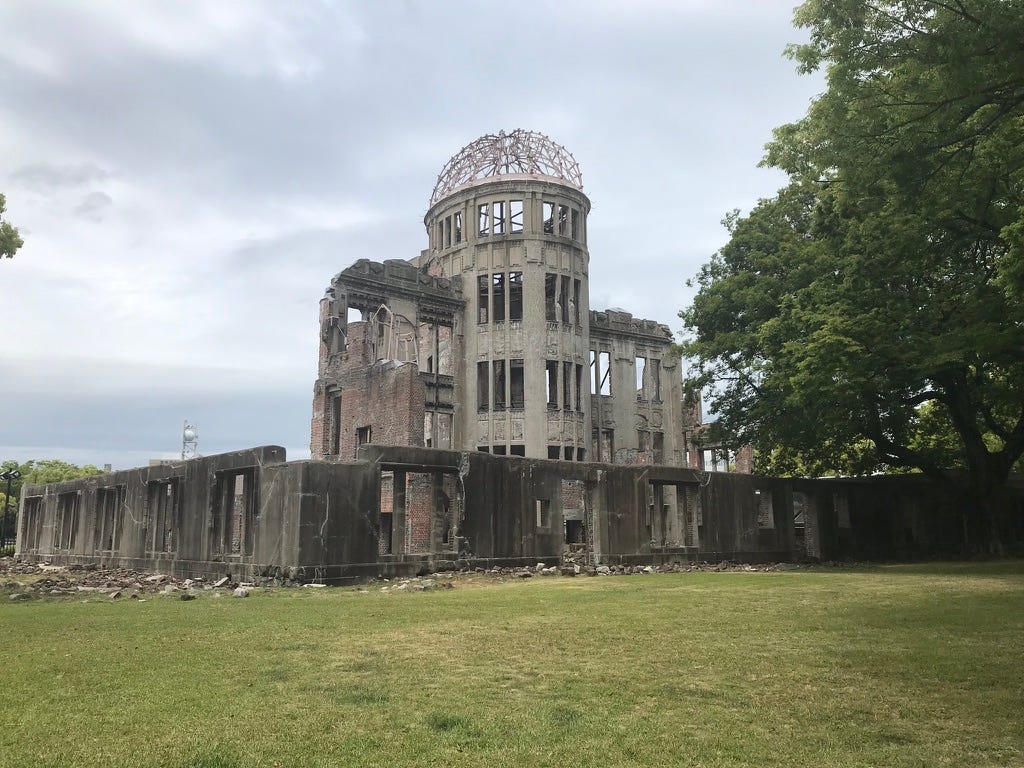Why I'm Obsessed with Japanese Mystery & Crime Fiction
....and now for something completely different.
Hi everyone!
This week, I’m reflecting on the intersection between a genre I love to read and a culture that I find endlessly fascinating.
The photos are all from my visit to Japan.
Enjoy!
Found in Translation
You can learn a lot about a culture through its crime and punishment (or law and order, if you prefer Dick Wolf’s phrasing — cha-chung).1
I have been obsessed with true crime since 1988, the first season of NBC’s Unsolved Mysteries hosted by the majestically cool Robert Stack. However, I went most of my life without reading mysteries or crime fiction. Not until I finished my PhD did I start, even though the genre clearly appealed to my sensibilities. I’ll be the first to say it was mostly snobbery — and there are a lot of by-the-numbers works out there.
But excellent crime fiction and mysteries are like chocolate and sugar spun sculptures: intricate assemblies that are deliciously indulgent. True pleasures that trigger no guilt, even when consumed in copious amounts.
And, if true crime can tell you a lot about a culture, so, too, can fictional crime.
I visited Japan — Osaka, Kyoto, Hiroshima, and Tokyo — for two weeks in 2019, as part of a two-month trip around East and Southeast Asia. Condé Nast Traveler readers recently voted Japan the best country to visit in the world. While I don’t put much stock in such lists, if I could snap my fingers and be anywhere in the world right now, it would be Japan.
(Itsukushima Shrine on Miyajima, about 40 minutes by ferry from Hiroshima)
Japan is gorgeous. It is clean. It blends the ancient with the unbelievably modern. The food is delicious. The people are unfailingly polite. The Tokyo metro is packed like sardine cans yet silent. Purchases are gift wrapped with the precision of origami masters. The toilets are miraculous.
And, as someone who grew up in America, loves British literature, and has long been a Europhile, I find Japan a culture so different from my own that it continues to intrigue me.
(Osaka at night)
I’m not in any way an expert on Japan, its people, or its culture, so my observations here are not as informed as I’d like them to be. But I hope that these reflections, if nothing else, inspire you to check out some of these works yourself.
Locked Rooms and the Long Game
The first Japanese mystery I read was Soji Shimada’s 1982 work Murder in the Crooked House. I still think about that book a lot, for two reasons: the locked room and the long game.
By locked room, I mean locked room mysteries. The history of modern Japanese mystery novels is one permeated with locked room mysteries, which book critic Tara Cheeseman defines as “three-dimensional puzzle mysteries inspired by the Golden Age of Western detective fiction.”2 In other words, these mysteries usually involve a murder victim found alone and dead in a room locked from the inside — a seemingly impossible situation. (Think Arthur Conan Doyle’s “The Speckled Band,” Agatha Christie’s And Then There Were None, and Gaston Leroux’s The Mystery of the Yellow Room.) In Japanese, these novels are called honkaku, or “orthodox.” Another key component of these mysteries is that they must provide the reader with all the clues to solve the mystery (referred to as “fair play”). Therefore, they often include floor plans and diagrams of the mysterious locked room where the victim is discovered.
Perhaps the best-known master of honkaku, Seishi Yokomizo, published his first novel, The Honjin Murders, in 1946. (Shimada’s Murder in the Crooked House is actually shin honkaku, or “new orthodox:” part of a renaissance of the genre that began in the early 80s.)
Murder in the Crooked House features an ingenious locked room mystery with an unbelievably complex solution, which I won’t give away because you should read the book. Its intricacy, however, isn’t only physical — it’s psychological. The murderer seeks revenge for an act that is decades old, and they have spent the intervening years carefully planning their life’s path around the revenge plot so that the murder could occur at the perfect moment to achieve maximum impact.
In other words: the long game. This level of patience and planning, which includes making sure the murderer and the victim are at just the right places in their lives economically, socially, emotionally, and of course physically, is frankly astonishing. It shows an infinite amount of patience. I hesitate to say something as big as “this is a facet of Japanese culture.” And yet there are definitely resonances to real life crimes, as well as other literary works.
For real-life crime, there’s the example of Ryoji Akashi. He planned for 12 years to poison everyone that bullied him in junior high school, studying chemistry in high school and college, and taking jobs at chemical companies, purely for the purpose of learning how to use and acquire large quantities of poison. In 1990, at the age of 26, he reached out to every student and teacher from his junior high school days to schedule a class reunion in their hometown. The date of the reunion was January 2, 1991, and everyone came — except Akashi. The evening went off without a hitch, but the next morning’s papers revealed a shocking truth. Akashi’s mother was suspicious of her son’s furtive actions before the reunion, and she discovered a diary entry in which he wrote, “I will kill them with bombs and poison.” He had laced beer with arsenic and created a bomb that blew up when the police came to investigate. (Three men were injured, but there were no fatalities.) He ultimately served six years in prison. Released in 1998, there’s no record of him after this, so presumably he hasn’t attempted revenge again. (Unless he’s doubled down on his patience and planning….)3
When it comes to fictional works, there’s the plot of the 2003 Korean action-thriller Oldboy, an adaptation of the Japanese manga of the same name. Again, I won’t give too much away, but the protagonist is subject to a revenge plot that takes more than 15 years to realize and has a deeply unsettling poetic justice to it.
Most notably, though, there are echoes of the famous Japanese revenge story that made waves in the west when written about by British diplomat A.B. Mitford in 1871: the tale of the 47 ronin. In 1703, 47 ronin, or masterless samurai, avenged the death of their lord nearly two years after his death. Their planning was impressive: one ronin even married the daughter of the builder who constructed their target’s home so that they could access the blueprints. Even though such revenge was illegal, and they were all prepared to face the disgrace of execution, the act was received so well by the public that the government ultimately offered them a compromise: the permission to commit seppuku, or ritual suicide. All but one of them did.4 Less well known, but earlier and even more in line with the long game theme, is the earlier revenge tale of the Soga brothers, whose father was killed when they were four and two years old, respectively. It took 18 years, but they finally achieved their revenge on their father’s murderer in 1193 when they were 22 and 20 years old.5
In our world of instant gratification and multitasking (aka doing everything at the same time and none of it well), this patience and planning is somewhat amazing to read. It reminds me of the revenge tragedies of Elizabethan and Jacobean England, though even Hamlet with its four-hour length and indecisive protagonist moves at a quicker pace.
In this sense, there is a direct line from the Soga brothers and the 47 ronin and the motivations and methods of the murderer in Shimada’s Murder in the Crooked House. But I even see connections with the Japanese art of origami: the planning, precision, and patience to fold a delicate, small square of paper a multiplicity of times until its final shape is revealed. With origami, that shape is a crane, or a frog, or a boat. With honkaku, it’s the perfect crime.6
A Window into the Past
Honkaku and shin honkaku novels tend to revolve around a Sherlockian-like detective genius. Shimada has Kiyoshi Mitarai. Yukito Ayatsuji has Kiyoshi Shimada (likely a nod to the author Soji Shimada, who has been called the father or godfather of shin honkaku).
And Seishi Yokomizo has Kosuke Kindaichi. Kindaichi is a scruffier Sherlock, a man somewhat out of step with both pre- and post-war Japan. He tends to wear traditional (old-fashioned?) haori jackets and a battered hat. His hair is described as “a rat’s nest,” mostly because he viciously scratches his scalp when excited (at one point, a client backs away from the shower of dandruff this causes). He also stutters.
I recently read the latest translation in the Kindaichi series, The Devil’s Flute Murders. Originally published in serialized form from 1951-53, the novel is set in 1947. The effects of the war are everywhere:
There were piles of broken roof tiles and scorched earth, and weeds were growing up unchecked between the heaps. But there were also signs of renewed activity, with those ubiquitous temporary buildings people had taken to calling ‘barracks.’7
The people carry visible scars, too. In multiple cases Kindaichi investigates, the true identity of men returning from war is in question, since they have been wounded so badly they are no longer recognizable. While I don’t want to downplay Japanese war atrocities, these books remind us how much the Japanese civilian population suffered as a result of the war.
Take this moment in The Devil’s Flute Murders:
Osumi recalled the terror of the air raids, how they turned the whole area into a sea of flame, and then how the crowds of fleeing people were raked by machine-gun fire. The kind of stories almost anyone who had lived through those times could share.8
As honkaku novels, these books focus more on plot than character. And the crimes are, almost by definition, outlandish. As I said, they’re the result of lengthy planning (though the criminals inevitably make some slight mistake that allow them to be caught), and they’re often motivated by long-held grievances or complex family dynamics. In other words, they’re exceptional actions.
In contrast, the glimpses of daily life in postwar Japan are utterly mundane but exist within a complex and rapidly changing context of flattened cities, charred forests, foreign occupation, black market trading, blackouts, rationed goods, disabled bodies, and endless other wounds, both physical and psychic.
(A-Bomb Dome, Hiroshima)
As a result, even though The Devil’s Flute Murders is set in 1947 and was first published in 1951, it already qualifies in some way as historical fiction. The Japan of 1947 would have looked very different from the Japan of 1951 as recovery picked up pace. The tools available to criminals, law enforcement, and the population at large would have been different, too. I’m reminded of the ways in which cellphones in our own time have enabled both better ways to commit crime (burner phones) and better ways to catch criminals (tracking cell phone data).
The crimes remain the same, but the methods change. We see this briefly near the end of The Devil’s Flute Murders, when Kindaichi’s police friend Chief Inspector Todoroki notes that a murder victim was killed with potassium cyanide:
“….The damned stuff is everywhere these days. You can’t get away from it. Another one of the war’s little gifts.”9
Recommendations
Most of these books are available through Pushkin Vertigo in a variety of forms, including e-book.
I loved both of Soji Shimada’s Kiyoshi Mitarai novels: The Tokyo Zodiac Murders and Murder in the Crooked House.
Pushkin Vertigo has published five of Seishi Yokomizo’s Kosuke Kindaichi novels so far, with a sixth due in 2024. Start with The Honjin Murders.
This Week’s Dose of K-Pop: Red Velvet レッドベルベット “WILDSIDE”
Before K(orean)-pop, there was J(apanese)-pop. Though J-pop never became as popular globally as K-pop is now, I recall hearing about bands like SMAP as a young adult.
Many K-pop groups release Japanese songs and even albums. The songs can be versions of existing singles with Japanese lyrics or stand-alone songs.
Since their debut in 2014, Red Velvet has been one of the most popular girl groups both in Korea and globally. They were the first K-pop group to perform in North Korea in 2018 in front of Kim Jong-un.
Their 2022 Japanese single “WILDSIDE” was an obvious choice given the theme of the music video, which presents the members as an Ocean’s 8 type group performing a heist. (Or at least dancing and/or posing around images like bank vaults, rooms with laser security systems, and gem under display cases. It’s also a great song about showing a side of yourself often kept hidden. The lyrics point to something more like female empowerment, but they’re general enough to apply to, say, someone who has plotted revenge for decades revealing their long-buried anger and hatred and the intricate plans they have wrought.
Love y’all,
Sara
I’m not the first person to make this observation, and I thought I had read this exact sentiment expressed somewhere. The best I can find is an interview with The New York Times Book Review’s crime and mystery columnist, Sarah Weinman from this past Halloween, “For One Writer, Crime Is a ‘Window’ Into Society.”
Usually seen as occurring between the two world wars and featuring authors including Agatha Christie and Ellery Queen.
This video about the incident is excellent and informative.
The final ronin, who had the lowest rank in the group, lived to the age of 87. Stories as to why he survived vary. Some say that he was sent as a messenger to announce that the revenge plan had worked, whereas others say that he fled to escape punishment. Others say that he was ultimately pardoned because of his youth, though one of the ronin who committed seppuku turned 16 on the day he died. This article is a fascinating look at the ongoing controversy.
There’s a great master’s thesis by Jasmin M. Curtis that analyzes this story in detail.
Yes, the murderer is found out. But it is always after the crime has been committed, and the murderer is often relieved, if not glad, to be brought out into the light. If you require vengeance, then .
The Devil’s Flute Murders, 172.
Idem.
Ibid, 303.






